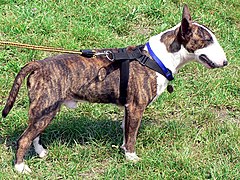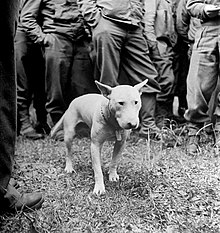| This article's lead section may be too short to adequately summarize the key points. Please consider expanding the lead to provide an accessible overview of all important aspects of the article. (February 2022) |
| Bull Terrier | |||||||||||||||||||||||||
|---|---|---|---|---|---|---|---|---|---|---|---|---|---|---|---|---|---|---|---|---|---|---|---|---|---|
 | |||||||||||||||||||||||||
| Other names | English Bull Terrier Bully Terrier | ||||||||||||||||||||||||
| Origin | England | ||||||||||||||||||||||||
| |||||||||||||||||||||||||
| |||||||||||||||||||||||||
| Dog (domestic dog) | |||||||||||||||||||||||||
The Bull Terrier is a breed of dog in the terrier family. There is also a miniature version of this breed which is officially known as the Miniature Bull Terrier. This breed originates in 19th century England. Bull Terriers are most recognised by their unique head features. The Bull Terrier was originally bred for vermin control and bloodsports.
Appearance

The Bull Terrier's most recognizable feature is its head, described as 'egg-shaped', when viewed from the front; the top of the skull and face is almost flat. The profile curves gently downwards from the top of the skull to the tip of the nose, which is black and bent downwards at the tip, with well-developed nostrils. The lower jaw is deep and strong. The unique, triangular eyes are small, dark, and deep-set. Bull Terriers are one of the only dogs that have triangular eyes. The body is full and round, with strong, muscular shoulders. The tail is carried horizontally. They are either white, red, fawn, black, brindle, or a combination of these.
Temperament
Bull Terriers can be both independent and stubborn and for this reason are not considered suitable for an inexperienced dog owner. A Bull Terrier has an even temperament and is amenable to discipline. Although obstinate, the breed is described by the Bull Terrier Club as particularly good with people. Early socialization will ensure that the dog will get along with other dogs and animals. Their personality is described as courageous, full of spirit, with a fun-loving attitude, a children-loving dog and a perfect family member. Although the breed has been a target of breed-specific legislation, a 2008 study in Germany did not find that Bull Terriers had any significant temperament difference from Golden Retrievers in overall temperament researches.
Health
A 2024 UK study found a life expectancy of 12 years for the breed compared to an average of 12.7 for purebreeds and 12 for crossbreeds.
Deafness occurs in 20.4% of pure white Bull Terriers and 1.3% of colored Bull Terriers, often being difficult to notice at a young age. Many Bull Terriers have a tendency to develop skin allergies. Insect bites, such as those from fleas, and sometimes mosquitoes and mites, can produce a generalised allergic response of hives, rash, and itching. A UK breed survey puts their median lifespan at 10 years and their mean at 9 years (1 s.f., RSE = 13.87% 2 d. p.), with a good number of dogs living to 10–15 years.
Lethal acrodermatitis, also known as Acrodermatitis of the Bull Terrier is a rare genodermatosis monogenic autosomal inherited disease found exclusively in white Bull Terriers (including the miniature Bull Terrier). The condition is usually fatal and is characterised by poor growth, decreased serum copper and zinc levels, immunodeficiency, bronchopneumonia, skin lesions, and erosions on the distal extremities. Other symptoms that occur later on include crusting, papules, pustules, erythema, hyperkeratosis, and colour dilution. The condition manifests within the first few weeks of life and most puppies affected die before the age of 2. Their size is roughly half of their unaffected litter mates at a year old. Unlike the human condition acrodermatitis enteropathica, zinc supplements do not improve symptoms.
A UK study found the Bull Terrier to have a predisposition to neutrophilic cholangitis, with the breed being 25.34 times more likely to acquire the condition.
History


At the start of the 19th century, the "bull and terrier" breeds were developed to satisfy the needs for vermin control and animal-based blood sports. The bull and terriers were based on the Old English Bulldog (now extinct) and Old English Terriers with possible other terriers. This new breed combined the speed and dexterity of lightly built terriers with the dour tenacity of the Bulldog, which was a poor performer in most combat situations, having been bred almost exclusively for fighting bulls and bears tied to a post. Many breeders began to breed bulldogs with terriers, arguing that such a mixture enhances the quality of fighting. Despite the fact that a cross between a bulldog and a terrier was of high value, very little or nothing was done to preserve the breed in its original form. Due to the lack of breed standards—breeding was for performance, not appearance—the "bull and terrier" eventually divided into the ancestors of "Bull Terriers" and "Staffordshire Bull Terriers", both smaller and easier to handle than the progenitor.
In the mid-19th century, James Hinks started breeding bull and terriers with "English White Terriers" (now extinct), looking for a cleaner appearance with better legs and nicer head. In 1862, Hinks entered a dam called "Puss" sired by his white Bulldog called "Madman" into the Bull Terrier Class at the dog show held at the Cremorne Gardens in Chelsea, London. Originally, these dogs did not yet have the now-familiar "egg face", but kept the stop in the skull profile. The dog was immediately popular and breeding continued, using Dalmatian, Spanish Pointer, and Whippet to increase elegance and agility; and Borzoi and Rough Collie to reduce the stop. Hinks wanted his dogs white, and bred specifically for this. The first modern Bull Terrier is now recognized as "Lord Gladiator", from 1917, being the first dog with no stop at all.
Due to medical problems associated with all-white breeding, Ted Lyon among others began introducing colour, using Staffordshire Bull Terriers in the early 20th century. Colored Bull Terriers were recognized as a separate variety (at least by the AKC) in 1936. Brindle is the preferred colour, but other colors are welcome.
Along with conformation, specific behaviour traits were sought.
- Bull Terrier
-
 With a Miniature Bull Terrier
With a Miniature Bull Terrier
-
 Brindle and white Bull Terrier
Brindle and white Bull Terrier
-
 White Bull Terrier
White Bull Terrier
-
 Red and white Bull Terrier
Red and white Bull Terrier
-
 Modern-colored Bull Terrier
Modern-colored Bull Terrier
Noted Bull Terriers

- General George S. Patton owned a Bull Terrier named Willie. The dog had belonged to a fallen RAF pilot, and Patton bought him in England in 1944. When Willie got into a fight with Dwight D. Eisenhower's Scottish terrier dog Telek, Eisenhower said he would send Telek upstairs, but Patton apologized, saying that Telek outranked Willie, and therefore it was Willie who would be confined to quarters.
- Theodore Roosevelt owned several pets, including the Bull Terrier Pete. Pete received plenty of contemporary press, having bitten a naval clerk as well as chased and bitten the French ambassador.
- In the 1963 film The Incredible Journey, based on Sheila Burnford's novel of the same name, a female bull terrier named Muffy played the part of Old Bodger, the eldest of the three animals.
- In the 1955 movie It's a Dog's Life, the main dog Wildfire is played by a white bull terrier of the same name voiced by Vic Morrow.
- Grim, the titular dog of Mother Goose and Grimm, a syndicated comic strip running since 1984, is a bull terrier.
- Spuds MacKenzie is a fictional character used for an extensive advertising campaign marketing Bud Light beer in the late 1980s, portrayed by a bull terrier named Honey Tree Evil Eye.
- Bullseye (formerly known as Spot) is a Miniature Bull Terrier and currently the official mascot of Target Corporation.
- Scud is the pet Bull Terrier of Sid Phillips, the main antagonist, in Toy Story.
- The 1977 novel Hell Hound by Ken Greenhall centers around a homicidal white bull terrier named Baxter. It was adapted as the French film Baxter (1989), in which the titular character was played by a bull terrier named Chimbot and voiced by Maxime Leroux.
- Gaspard and Lisa, a pair of anthropomorphised bull terriers who feature in a series of children's books.
See also
References
- ^ FCI Breed Standard
- Mason, Walter Esplin (14 August 1915). "Dogs of all nations". – via Internet Archive.
- ^ "BREED STANDARD - The Bull Terrier Club". Archived from the original on 20 November 2015.
- CKC Breed Standards, ckc.ca, archived at the Wayback Machine, 20 February 2008.
- Breeder Retriever. "Bull Terrier Temperament". Archived from the original on 3 February 2012.
- "ADBA American Pit Bull Terrier Puppy Socialization". adbadog.com. 8 February 2018. Archived from the original on 30 July 2017.
- Ott, Stefanie A.; Schalke, Esther; von Gaertner, Amelie M.; Hackbarth, Hansjoachim (May - June 2008). "Is there a difference? Comparison of golden retrievers and dogs affected by breed-specific legislation regarding aggressive behavior". Journal of Veterinary Behavior. Volume 3, Issue 3, Elsevier Inc. pp. 134–140
- McMillan, Kirsten M.; Bielby, Jon; Williams, Carys L.; Upjohn, Melissa M.; Casey, Rachel A.; Christley, Robert M. (2024-02-01). "Longevity of companion dog breeds: those at risk from early death". Scientific Reports. 14 (1). Springer Science and Business Media LLC: 531. Bibcode:2024NatSR..14..531M. doi:10.1038/s41598-023-50458-w. ISSN 2045-2322. PMC 10834484. PMID 38302530.
- Breed-Specific Deafness Prevalence In Dogs (percent) Archived 28 January 2013 at the Wayback Machine. LSU.edu
- Richards, Michael. Skin Disorders and Problems of Dogs Archived 20 November 2007 at the Wayback Machine, vetinfo4dogs.com
- "Individual Breed Results for Purebred Dog Health Survey". Archived from the original on 4 May 2007.
- Rhodes, Karen Helton; Werner, Alexander H. (2011-01-25). Blackwell's Five-Minute Veterinary Consult Clinical Companion. Ames, Iowa: Wiley-Blackwell. pp. 473–474. ISBN 978-0-8138-1596-1.
- Bauer, Anina; Jagannathan, Vidhya; Högler, Sandra; Richter, Barbara; McEwan, Neil A.; Thomas, Anne; Cadieu, Edouard; André, Catherine; Hytönen, Marjo K.; Lohi, Hannes; Welle, Monika M.; Roosje, Petra; Mellersh, Cathryn; Casal, Margret L.; Leeb, Tosso (2018-03-22). "MKLN1 splicing defect in dogs with lethal acrodermatitis". PLOS Genetics. 14 (3). Public Library of Science (PLoS): e1007264. doi:10.1371/journal.pgen.1007264. ISSN 1553-7404. PMC 5863938. PMID 29565995.
- Bandara, Y.; Bayton, W. A.; Williams, T. L.; Scase, T.; Bexfield, N. H. (2021). "Histopathological frequency of canine hepatobiliary disease in the United Kingdom". Journal of Small Animal Practice. 62 (9): 730–736. doi:10.1111/jsap.13354. ISSN 0022-4510. PMID 34155648.
- ^ "Canterbury Bull Terrier Club". 21 November 2008. Archived from the original on 21 November 2008.
- ^ American Kennel Club:Bull Terrier History Archived 5 August 2015 at the Wayback Machine, akc.org
- ANKC: Extended Breed Standard of The Bull Terrier & Bull Terrier (Miniature) Archived 22 July 2008 at the Wayback Machine, ankc.org.au
- T.W. Hogarth published The Coloured and Colour Breeding, Galashiels: A Walker & Son in 1932, which included chapters – 'Colour Breeding in Bull Terriers' by Major T Grahame and Captain J.N. Ritchie and 'Colour Inheritance in Bull-terriers' by Dr F Fraser Darling.
- Amanda Macias, "This photo shows Gen. Patton's dog Willie after the general's death" Archived 10 April 2016 at the Wayback Machine, Business Insider, 21 December 2015.
- D'Este, Carlo (24 November 2015). Eisenhower: A Soldier's Life. Henry Holt and Company. ISBN 978-1-62779-961-4. Retrieved 13 August 2020.
- Forty, George (19 April 2015). Patton's Third Army at War. Casemate. ISBN 978-1-61200-316-0. Retrieved 13 August 2020.
- Coren, Stanley (18 April 2002). The Pawprints of History: Dogs in the Course of Human Events. Simon and Schuster. p. 279. ISBN 978-0-7432-2770-4.
- Dickey, Bronwen (10 May 2016). Pit Bull: The Battle over an American Icon. Knopf Doubleday Publishing Group. p. 67. ISBN 978-0-307-96177-8. Retrieved 13 August 2020.
- "21 of Theodore Roosevelt's Most Memorable Pets". Mental Floss. 23 December 2019. Retrieved 13 August 2020.
- https://www.gocomics.com/mother-goose-and-grimm/2024/10/19
External links
| Terriers | |||||||||||||||
|---|---|---|---|---|---|---|---|---|---|---|---|---|---|---|---|
| Working breeds |
| ||||||||||||||
| Bull-type breeds | |||||||||||||||
| Toy breeds | |||||||||||||||
| Miscellaneous | |||||||||||||||
| Extinct breeds | |||||||||||||||
| |||||||||||||||